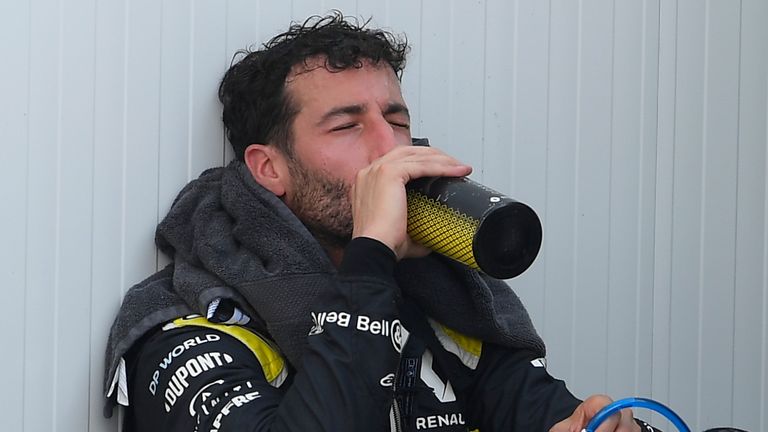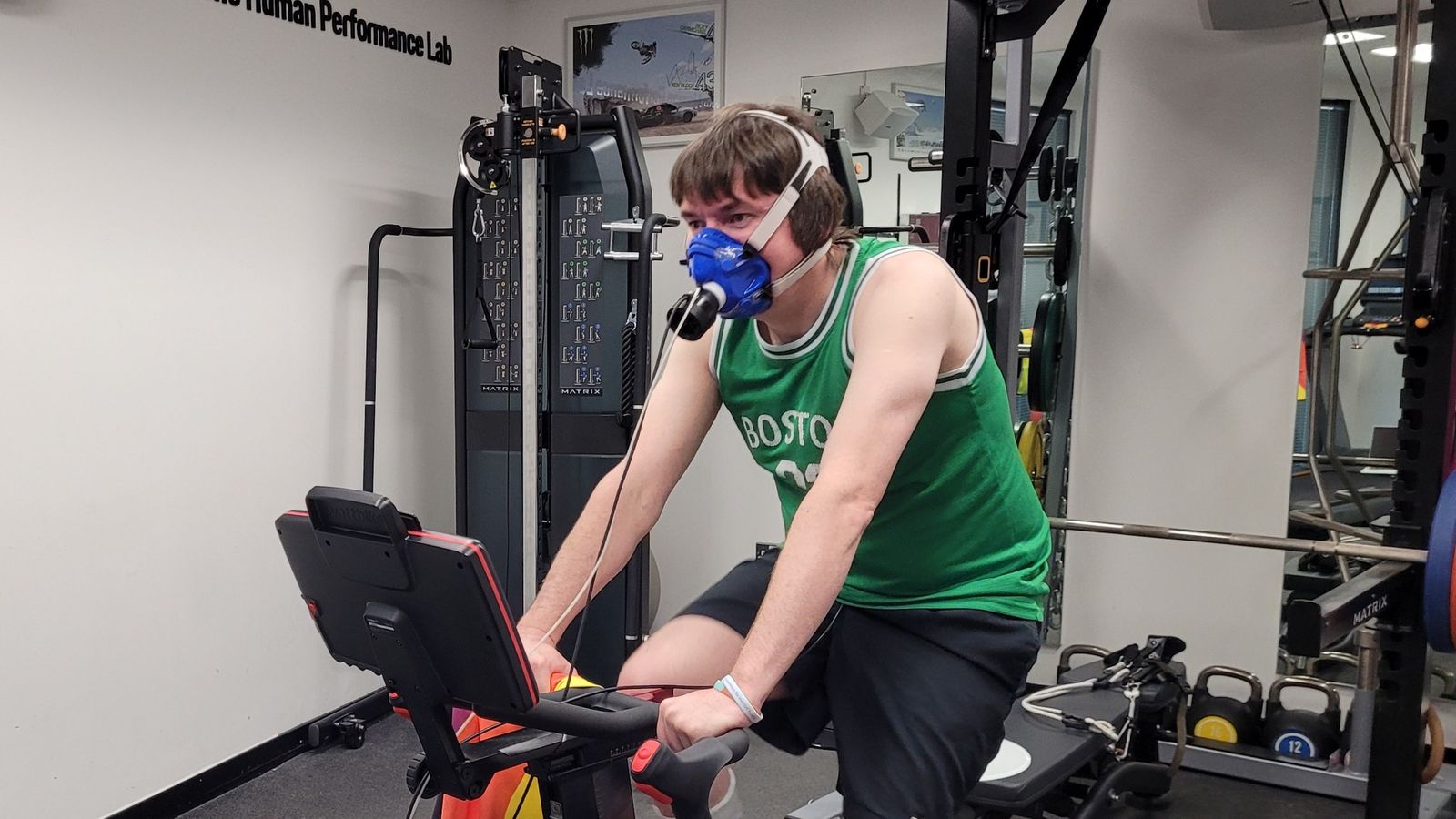Azerbaijan Grand Prix: How drivers stay at their peak to cope with the extremes of Baku

Sky Sports journalist Marc Bazeley gets put through his paces to see how he matches up to a Formula 1 driver
In terms of physical preparation, Formula 1 has come a long way since the days where a warm-up meant driving a few laps of the track on the morning of a race and rehydrating perhaps involved champagne on the podium more than drinks containing complex electrolytes.
Contrary to popular belief, there is more to it than just sitting behind the wheel and racing around for a couple of hours on a Sunday. The modern Formula 1 driver has to be at the peak of both mental and physical condition to cope with the extremes of piloting some of the most advanced racing cars on the planet.
Repeated exposure of forces of up to 6g under braking lap after lap, wrestling to keep control of cars capable of speeds of over 200mph and having to maintain high levels of concentration are just some of the challenges posed to them.
Added into the mix are things which cannot be controlled like the heat inside the cockpit while wearing fireproof overalls, racing gloves and shoes and a helmet, as well as the balancing act of trying to keep their own weight down as much as possible so as not to compromise car performance.
“We want the drivers to be light, but we also want them to have a decent muscle mass to cope with the strength demands of the sport,” Jack Wilson, the Porsche Human Performance Centre’s lead sports scientist, told Sky Sports.
“Some of it touches on their upper-body strength, they also need great core strength to tolerate g-force and being thrown around in the cockpit and lower-body strength for brake application.
“How do they achieve that? They make sure their body fat is as low as it can be within a healthy range because having a low level of body fat permits you to have a decent amount of muscle mass and stay lightweight.

Ahead of this weekend’s Azerbaijan Grand Prix, we look back at some of the most memorable moments from previous races in Baku.
“One of the most important risks of having such a lean composition is compromised immune function. Drivers are travelling overseas every other week, if not more – so therefore sleep is interrupted – you’re coming into close contact with lots of people, so that’s quite an interesting balancing act to play with the drivers as well, maintaining a lean body-far percentage while having a fully supported immune system.”
This weekend’s 51-lap Azerbaijan Grand Prix is one of the biggest tests of all those areas – a 20-corner circuit around the capital city Baku with long straights and tight corners. At a shade over 6km in length, it is the third-longest track on the calendar, while temperatures in the cockpit can reach up to 44 degrees centigrade during the race in summer on the Europe-Asia border.
It is why, on a somewhat cooler grey English Midlands afternoon at the start of race week, we find ourselves in the laboratory of the Porsche Human Performance Centre at Silverstone to undergo a battery of tests which will give an idea of the levels the world’s best drivers have to be at.
After a body composition analysis, it is straight onto the Batak light board to test reactions, followed by examining grip strength and then neck strength. Next up it is onto the watt bike for the VO2 max test to determine endurance, as well as a Stroop test before and afterwards to see how much tiredness affects cognitive functions.

Sky Sports journalist Marc Bazeley undergoes a neck strength test
Rounding it all off is a run on the treadmill in the heat chamber and then a sweat test to determine how much sodium – vital for regulating the body’s fluid balance and retention, blood viscosity and cognitive function – you lose when you sweat.
That varies from person to person and given its importance in keeping balance in the body, is something included in supplements the drivers will add to their drinks they have in their car for each race. Even then though, that does not always solve the problem of dehydration at Grand Prix like Azerbaijan.
“Most of them, particularly for those hot, humid races will have some fluid in the car,” Abby Coleman, lead sports scientist at Precision Fuel and Hydration, told Sky Sports.
“It will contain electrolytes, it will contain carbohydrate, but the counter to that is the fluid is there, but whether they drink it is a question mark. Because of the heat in the car, that fluid heats up pretty rapidly and can make it quite unpleasant.
Average person vs Formula 1 driver
| Category | Marc Bazeley | Ideal Formula 1 driver |
|---|---|---|
| Height | 182cm | Up to 186cm |
| Weight | 79kg | High 60s-low 70s kg |
| Percentage body fat | 20% | 8-12% |
| Batak test | 76 lights per minute | 120-plus lights per minute |
| Grip strength | 34kg right, 31kg left | 55-65kg |
| VO2 max | 32mL/(kg-min) | High 50s-low 60s mL/(kg-min) |
“Drinking hot water when you’re already uncomfortably warm in that suit, helmet, gloves and boots, what you really want is something cool and refreshing and that liquid is far from that.
“That’s why some athletes will not drink enough so that’s why that’s not uncommon for some to finish a race two per cent dehydrated which the literature would suggest can impede cognitive function, which is not what we want the drivers to experience. You have to take those factors into consideration.”
Drivers are also limited to carrying a litre-and-a-half of liquid in the drink bags which go in the car and any more would create a headache for the team’s engineers in where else to try to save weight while ensuring the person in the car does not suffer compromised performance levels.
The way to get around that is to try to ensure drivers are hydrated as much as possible prior to getting in the car, although it is more than just a case of taking on litre after litre of water before starting a race.

Staying hydrated is vital for Formula 1 drivers to help maintain cognitive function behind the wheel
“If we are drinking a lot of plain water, we risk diluting the body’s blood sodium levels and end up going to the toilet a lot and start with low fluid and low sodium,” Coleman said. “The idea of pre-hydration is drinking a high-sodium drink before the race.
“If you put a fluid in the body which contains quite a high degree of sodium, it creates an imbalance the other way and the body isn’t going to get rid of that fluid to make that imbalance any worse, it tries to retain it.
“You start with this buffer of fluid and sodium, something the athlete is potentially going to sweat out in the car in quite large proportions. That’s the part that is hopefully more controllable.”
As someone who can see 40 rapidly speeding towards me on the horizon and whose own sporting activities are very much below elite level, it should come as no surprise my own testing results do not quite match up to those of Formula 1’s competitors.

Sky Sports journalist Marc Bazeley undergoes a sweat test
Nevertheless, what it does underline is just how much these drivers are as much athletes as any other sportspeople – and just how much more there is to Formula 1 than getting behind the wheel and driving.
“The key thing with drivers is the multi-faceted nature to their fitness,” Wilson said. “You might get individuals who might be decent in one or two across these areas, but to be at F1 standard across the board is quite special.”
Watch the Azerbaijan Grand Prix, live on Sky Sports F1, with coverage starting on Friday at 11.40am.





Pingback: BUY MAGIC MUSHROOM GERALDTON
Pingback: https://www.shathabdhitownships.com/wp-content/uploads/2021/05/page4.html
Pingback: https://www.ccrriosp.com.br/desktop?url=https://toreroband.com/
Pingback: สล็อตวอเลท
Pingback: check over here
Pingback: medicamente pentru ficat